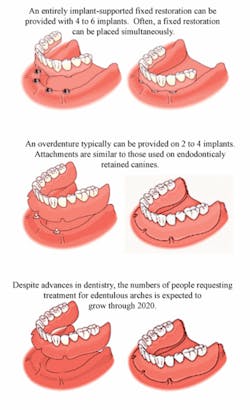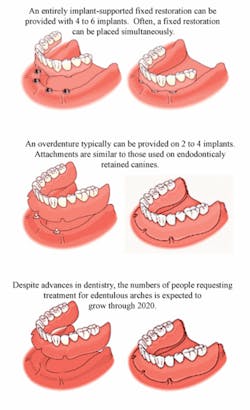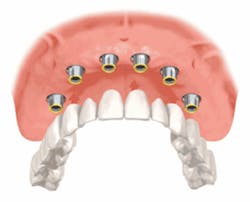Dentures and Dental Implants: a growth area for the dental practice
by Patricia Sullivan
More than 30 million Americans currently are missing all their teeth in one or both jaws. Despite advances in dentistry, that number is expected to grow as the population ages. As a consequence, demand for dentures is expected to increase through at least the year 2020. Dentists in general practice may wish to participate in this market, particularly when they consider that many prospective patients will be financially independent. Reasons dentists may not be currently seeing denture patients include previous frustrations with results, perceptions that dentures are a dying aspect of dentistry, or thinking that dentures do not fit the esthetically driven restorative practice. Realizing that a sizeable percentage of adults in your area will be seeking this treatment for years to come may give you pause to reconsider this developing growth area. So may the fact that some denture teeth and acrylic manufacturers, as well as denture technicians, have been keeping pace with other aspects of esthetic dentistry, making highly esthetic - even artistic - dentures possible.
For dentists who are not providing denture services, the decision to start can have profound benefits. It can expand the practice’s patient base through referrals from existing patients when they hear about the new services. Many dentists and staff enjoy providing denture services because of the absence of procedures such as local anesthesia delivery and ease of operatory set-up. Among denture patients, a subset will seek implant prosthetic alternatives. For dentists who already provide denture services, dental implants are a natural extension of this service. Implants can be combined with dentures for both overdenture and fixed-bridge alternatives.
There are many reasons why overdentures on implants are a popular and growing treatment option. The use of freestanding attachments or bar/clip designs that use endodontically retained canine and premolar teeth has a long history of patient success. It is only natural that this concept be extended to dental implants, which can function as artificial tooth roots. Many of the popular attachments for anchorage using retained tooth roots for overdenture retention have been modified for use with dental implants. The addition of implant-retained overdentures to denture prosthetics is an easy transition with a minimal investment.
Another reason for the popularity of overdentures is the understandable desire of dentists to provide the least-invasive treatment possible to solve their patients’ problems. For the patient who already has a denture and is complaining about looseness, denture adhesives, or lack of confidence when speaking or eating, the retention provided by dental implants will be a significant improvement. Dentures can often be retrofitted to dental implants with the use of attachments, creating an easy-to-provide service in a general practice.
There are many approaches to overdentures, usually involving two, three, or four implants. Many dentists see this as the most economical and least-invasive way to solve the patient’s denture problems. A 2002 consensus conference held at McGill University in Montreal confirmed this. Based on economics and quality of life, clinicians and faculty from throughout North America declared that the two-implant overdenture was the minimum standard of care for people without any lower teeth.
Their conclusion was:
“The evidence currently available suggests that the restoration of the edentulous mandible with a conventional denture is no longer the most appropriate first-choice prosthodontic treatment. There is now overwhelming evidence that a two-implant overdenture should become the first choice of treatment for the edentulous mandible.”
To bring someone from a loose denture to an implant-retained overdenture is a rational and natural stepping stone in the progression of implant technology.
Many dentists assume that the main or only application for dental implants for the edentulous patient is to retain overdentures. The coexisting market for fixed bridges on dental implants currently is quite small. Surveys of dental laboratories indicate that providing fixed restorations on implants for the fully edentulous arch represents a non-existent or very small segment of the laboratories’ implant services. Interviews with dentists at implant continuing-education programs confirm that similarly small numbers have provided this service.
In my opinion, however, this situation is on the verge of a major transformation. To take a human being with failing dentition or existing dentures and provide him or her with a truly fixed restoration approximating an arch of natural teeth is a dramatic development in science and clinical practice. Those dentists who do have experience with both overdentures and implant-supported fixed bridges usually find that overdentures often don’t offer patients all the benefits available from fixed bridges. There are thus huge opportunities for dentists to take advantage of fixed-restoration treatment on behalf of their current and future patients.
Overdentures with full-border extensions still rely on the denture-bearing areas of the soft tissue for occlusal support. The implants provide retention in lieu of adhesives, but the ridges provide the support for the chewing function. With a fixed bridge, both the lingual and labial border extensions may be fully removed. For most upper implant restorations, the palatal contours mimic only the contours of lost teeth and gingiva, with no palatal encroachment whatsoever. While the restoration may abut the ridge crest as a pontic, oral hygiene is maintainable and phonetics are unimpaired.
Several advances in treatment of the fully edentulous arch have occurred during the past several years. Dental practices that do not provide implants as well as those that provide crowns and overdentures should look closely at developments in full-arch fixed restorations. Patients with edentulous arches are seeking the functional and esthetic results achievable with full-arch fixed restorations, and they have never been easier to provide.
Esthetics
When first introduced to North America in 1982, full-arch restorations known as “hybrids” were not embraced by many esthetically driven practices. Overdentures with flange extensions were thought to be a more esthetic alternative. Today, however, advances in frame materials, framework designs, ceramics, and even denture teeth have all helped make it possible to achieve restorations that meet or exceed the capabilities of nonimplant or overdenture restorations. Understanding implant placement and the ability to place implants precisely is the foundation of these esthetic results. More predictable stability of soft tissue and bone around the implants helps maintain the esthetic results.
Numbers of implants
When implants were first introduced, it was believed that a minimum of six implants were required to support a fixed restoration. Throughout the last 20 years, five to eight implants have been routinely provided for fixed bridge support. Today, however, 10-year data shows that once a minimum of four well-placed implants have integrated with the bone, additional implants may be unnecessary. Several studies, for both upper- and lower-jaw fixed bridges, have demonstrated success with just four implants.
Immediate function
For the millions of people who still face removal of terminal dentition, treatment with a fixed implant restoration has become more streamlined. A protracted series of staged surgical and restorative interventions is no longer always necessary. Techniques that allow for implant placement at the time of extraction followed by immediate restoration with a fixed provisional prosthesis have proven predictable and repeatable. Many patients today can have their terminal dentition replaced by an implant-supported fixed restoration in a single visit. In some instances, with proper planning, dental practices can deliver fixed restorations within five minutes of implant placement.
Guided implant placement
Minimally invasive surgical procedures are on the upswing within medicine and surgery in general. A major contributor to easy esthetics, optimal placement of fewer implants, and full-arch prosthesis availability at the time of implant placement is computer-guided implant placement. This is an oral-surgery variation of the minimally invasive surgery trend.
The NobelGuide technology (Nobel Biocare, Yorba Linda, Calif.) involves taking scans of the patient’s oral structures and existing denture using relatively low radiation. With the aid of such computer-guided surgery and prosthetic treatment, dentists can provide a full-arch fixed restoration, either provisional or definitive, including the placement of four to six implants, in as little as one hour per arch (not including anesthesia time).
This is accomplished with local anesthetic, and typically does not require either a soft-flap incision for access or sutures for wound closure. Note that the planning and fabrication time to deliver the full-arch fixed bridge within one hour is preceded by several weeks of preparation time.
For patients who typically were offered multiple implant and/or grafting surgeries and restorative visits, the appeal of a minimally invasive alternative with immediate results is obvious. For the dental technician, surgeon, and restorative dentist, the precision with which implant placement can be provided when preceded by “virtual implant placement” is quite remarkable. The fact that this precision can be achieved without a scalpel or sutures, while possibly improving both short- and long-term results, means even the most experienced implant-treatment providers have embraced guided implant placement. An additional contribution of computer-based guided surgery is that many more patients qualify for treatment without bone-grafting procedures. The ability to precisely use residual host bone without bone grafting shortens treatment times and decreases surgeries and costs, potentially increasing patient acceptance of these procedures.
The prosthesis delivered at the time of implant placement is made from information provided by a digital scan of the patient’s existing denture. Remarkably, an implant-level impression is not necessary. Instead, the computerized information about implant positions is transferred to the surgical template, which the dental technician uses to produce the implant-level model. With careful preoperative planning, including denture evaluation and occlusal registration, no intermediary appointments are required before delivery of the fixed implant restoration at the time of implant placement. This enables a dentist with removable-denture experience, but not implant-restorative experience, to easily provide a high-level implant restoration. For dental technicians, this advance makes for more routine and predictable prosthesis fabrication.
Complications of treatment of the fully edentulous arch are well defined and usually limited. With adequate planning, this is a highly predictable procedure. Dentists and patients both benefit from the techniques and materials refined during the past 40 years. The participation of dental laboratory technicians in continuing education, treatment planning, and other aspects of technical development has contributed to the success of full-arch implant restorations. The ability to provide both fixed and overdenture implant alternatives in a restorative practice today brings a high value of service to the local community.
Financial considerations
Because only two implants may be used to retain an overdenture, especially in the lower jaw, an overdenture approach offers some cost savings. However, the additional stability and superior function achievable with a fixed restoration persuades many patients to make the additional investment.
Both implant-supported overdentures and fixed restorations entail some maintenance costs. Overdenture attachment components wear out and must be replaced every year or so. While those component costs tend to be low, some patients find the requisite chair time and unpredictable nature of the component failures an annoyance. In contrast, fixed dentures may require replacement of denture teeth more often than implant-supported overdentures because of increased tooth wear secondary to the fixed restoration’s increased function. Fixed denture teeth require replacement at varying rates, depending upon such factors as whether the patient bruxes, wears a night guard, and so on. To provide continuous fixed function if repairs or maintenance are necessary, back-up fixed restorations can be made of acrylic.
Dentists who want to provide implant-supported restorations must be prepared to make some initial investments. A basic proficiency with fabricating dentures is essential. An estimated 16 to 24 hours of implant prosthodontic study focusing on screw-retained prosthetics, hands-on time with components, and self-study is recommended. The restorative dentist also should plan to invest approximately $1,000 for instrumentation. (An implant-placement armamentarium requires additional investment.) A return on investment can be expected with the first patient treated.
Every interested dental practice can expect growth in full dentures from several areas. There are requests for making new full dentures for improved function or appearance. Regrettably, some people will continue to lose all their teeth, making a full-arch dental restoration necessary. Additionally, public awareness of the benefits of dental implants used with dentures will continue to expand. Every dentist and staff member who has the opportunity to discuss dentures with patients should be familiar with all three alternatives: conventional dentures, implant overdentures, and implant fixed-bridge alternatives. Practices not currently offering their edentulous patients the benefits of implant restorations should consider the growth potential of this rewarding aspect of dental practice. Those who provide overdentures but not a completely fixed denture alternative will find that many patients are willing to invest in this additional level of service. The availability of third-party financing can often put the most optimal care within reach. When presenting treatment options and giving denture patients the benefits and limitations of both fixed and overdenture alternatives, you may be surprised how many opt for the benefits of the implant solutions!
Editor’s note: References available upon request.
Pat Sullivan has worked in the fields of dental implant education, clinical private practice and marketing for the past 15 years. Sullivan is currently enrolled in the Leadership and Management for the Dental Professional program, University of Southern California School of Dentistry and Marshall School of Business, and works in the sales support department of Nobel Biocare USA. Reach her via e-mail at [email protected]



